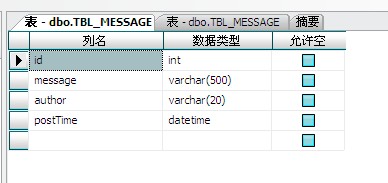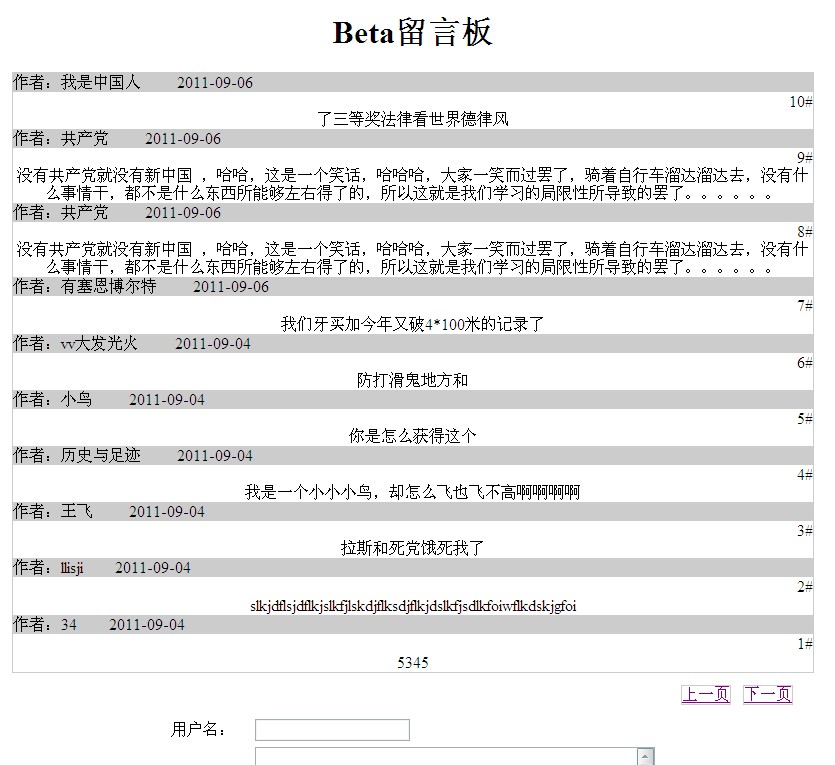jsp分页技术的例子实现和总结
2011-09-07 22:16
579 查看
在jsp开发中,在前台的数据展示页面,经常遇到这样的情况,很多条的数据,有几十上百条,而只显示10条,然后翻页显示下面的十条,如下图所示:

处理方式:一:首先sql语句,使用not in的方式处理,
在dao类里写一个方法
public List<> getAllByPage(int pageSize,pageNum){
......
String sql="select top"+pageSize +" * from 表名x where 字段A not in (select top "+pageSize*(pageNum-1)+" 字段A from 表名x)";
.......
rerun list;
}
其中,pageSize是页面要显示的条数,pageNum是要显示的页码,其中的sql语句基本是固定的,返回一个list对象。
二:在Biz里写一个方法,调用Dao里的这个getAllByPage方法,传入的也是两个参数,返回的也是list结果集。
三:在jsp页面以url传参的方式进行页面处理和数据的显示。
使用request对象获取传入的值,然后进行强制类型转换之后就可以作为参数,传入到Biz业务类的方法中去处理,返回的就是list结果集,然后使用表达式的方式在页面中进行显示就可以了。
综上:这就是分页显示数据的一个方法,
下面是一个小小的例子。
问题需求:开发一个小的留言板页面,页面能够以分页的形式显示所有留言信息,下放是一个发表留言的表单。
所有代码如下:
数据库如图:

实体类(entity)如下:
dao类如下:(包括链接jdbc数据库)
Biz类如下(调用dao的相关方法来实现业务处理):
测试index页面代码如下:
处理表单提交的jsp页面doPost.jsp如下:
页面效果如下:


处理方式:一:首先sql语句,使用not in的方式处理,
在dao类里写一个方法
public List<> getAllByPage(int pageSize,pageNum){
......
String sql="select top"+pageSize +" * from 表名x where 字段A not in (select top "+pageSize*(pageNum-1)+" 字段A from 表名x)";
.......
rerun list;
}
其中,pageSize是页面要显示的条数,pageNum是要显示的页码,其中的sql语句基本是固定的,返回一个list对象。
二:在Biz里写一个方法,调用Dao里的这个getAllByPage方法,传入的也是两个参数,返回的也是list结果集。
三:在jsp页面以url传参的方式进行页面处理和数据的显示。
使用request对象获取传入的值,然后进行强制类型转换之后就可以作为参数,传入到Biz业务类的方法中去处理,返回的就是list结果集,然后使用表达式的方式在页面中进行显示就可以了。
综上:这就是分页显示数据的一个方法,
下面是一个小小的例子。
问题需求:开发一个小的留言板页面,页面能够以分页的形式显示所有留言信息,下放是一个发表留言的表单。
所有代码如下:
数据库如图:

实体类(entity)如下:
package com.rz.entity;
import java.util.Date;
public class Message {
private int id; //留言id
private String message; //留言信息
private String author; //留言作者
private Date postTime; //留言时间
public int getId() {
return id;
}
public void setId(int id) {
this.id = id;
}
public String getMessage() {
return message;
}
public void setMessage(String message) {
this.message = message;
}
public String getAuthor() {
return author;
}
public void setAuthor(String author) {
this.author = author;
}
public Date getPostTime() {
return postTime;
}
public void setPostTime(Date postTime) {
this.postTime = postTime;
}
}dao类如下:(包括链接jdbc数据库)
package com.rz.dao;
import com.rz.entity.*;
import java.sql.*;
import java.util.*;
public class MessageDao {
private String driver="com.microsoft.sqlserver.jdbc.SQLServerDriver";
private String url="jdbc:sqlserver://localhost:1433;DataBaseName=message";
private String name="sa";
private String password="lishiyuzuji";
/**
* 保存一条记录
* @param message
* @return
*/
public int save(Message message){
int line=0; //保存记录的行数
Connection con=null;
PreparedStatement pstat=null;
try{
con=getConn();
pstat=con.prepareStatement("insert into TBL_MESSAGE(message,author,postTime) values(?,?,getdate())");
pstat.setString(1,message.getMessage());
pstat.setString(2,message.getAuthor());
line=pstat.executeUpdate();
}catch(SQLException e){
e.printStackTrace();
}finally{
closeAll(null,pstat,con);
}
return line;
}
/**
* 分页显示信息
* @param pageSize 每页显示的信息数量
* @param pageNum 定位到那一页
* @return
*/
public List<Message> listByPage(int pageSize,int pageNum){
Connection con=null;
PreparedStatement pstat=null;
ResultSet res=null;
List<Message> list=new ArrayList<Message>();
try{
con=getConn();
pstat=con.prepareStatement("select top "+pageSize+
" * from TBL_MESSAGE where id not in (select top "+pageSize*(pageNum-1)+
" id from TBL_MESSAGE order by postTime) order by postTime");
res=pstat.executeQuery();
while(res.next()){
Message message=new Message();
message.setId(res.getInt(1));
message.setMessage(res.getString(2));
message.setAuthor(res.getString(3));
message.setPostTime(res.getDate(4));
list.add(message);
}
}catch(SQLException e){
e.printStackTrace();
}finally{
closeAll(res,pstat,con);
}
return list;
}
/**
* 获得记录的总条数
* @return 返回查询到的所有记录的总条数
*/
public int getAllUserCount(){
Connection con=null;
PreparedStatement pstat=null;
ResultSet res=null;
int ret = 0;
try{
con=getConn();
pstat=con.prepareStatement("select count(*) from TBL_MESSAGE");
res=pstat.executeQuery();
if(res.next()){
ret=res.getInt(1);
}
}catch(SQLException e){
e.printStackTrace();
}finally{
closeAll(res,pstat,con);
}
return ret;
}
/**
* 连接数据库
*/
public Connection getConn(){
Connection con=null;
try{
Class.forName(driver);
con=DriverManager.getConnection(url,name,password);
}catch(ClassNotFoundException e){
e.printStackTrace();
}catch(SQLException e){
e.printStackTrace();
}
return con;
}
/**
* 关闭数据库连接,而且三者是有顺序的,先关闭ResultSet连接,接着关闭Statement连接,最后关闭Connection连接
* 并且还要抛出异常。数据库连接使用完毕以后需要关闭连接的,否则,连接数据库的“通道”就会继续增加,而数据库的连接
* 能力也是有限的,大约是200个,因此需要在使用完数据库后将连接关闭掉。
* @param res
* @param stat
* @param conn
*/
public void closeAll(ResultSet res,PreparedStatement pstat,Connection con){
try{
if(res!=null){
res.close();
res=null;
}
if(pstat!=null){
pstat.close();
pstat=null;
}
if(con!=null){
con.close();
}
}catch(SQLException e){
e.printStackTrace();
}
}
}Biz类如下(调用dao的相关方法来实现业务处理):
package com.rz.Biz;
import java.util.*;
import com.rz.dao.*;
import com.rz.entity.*;
public class MessageBiz {
/**
* 保存一条信息
* @param message
*/
public void saveMessage(Message message){
MessageDao messageDao=new MessageDao();
messageDao.save(message);
}
/**
* 根据页码来查询数据
* @param page
* @return
*/
public List<Message> listByPage(int pageSize,int pageNum){
MessageDao messageDao=new MessageDao();
return messageDao.listByPage(pageSize,pageNum);
}
/**
* 返回查询到的记录的总条数
* @return
*/
public int getAllUserCount(){
MessageDao messageDao=new MessageDao();
return messageDao.getAllUserCount();
}
}测试index页面代码如下:
<%@ page language="java" import="java.util.*,com.rz.Biz.*, com.rz.entity.*" contentType="text/html; charset=utf-8"%>
<!DOCTYPE HTML PUBLIC "-//W3C//DTD HTML 4.01 Transitional//EN">
<html>
<head>
<title>留言板系统</title>
<script>
function check(){
var name=document.form.text.value;
var pass=document.form.textarea.value;
if(name.length==0){
alert("用户名不得为空!");
return false;
}
if(pass.length==0){
alert("留言信息不能为空!");
return false;
}
return true;
}
</script>
</head>
<body style="text-align:center;">
<h1>Beta留言板</h1>
<div style="width:800px; border:#CCCCCC solid 1px;">
<%
String p=request.getParameter("p");
int pageNum=1; //定义页数
int pageSize=10; //定义每一页显示的个数
if(p!=null){ //判断传入的输入值是否为空,并且进行强制类型转换
pageNum=Integer.parseInt(p);
}
MessageBiz messageBiz=new MessageBiz();
List<Message> list=messageBiz.listByPage(pageSize,pageNum); //根据传入的两个参数,返回一个list集合
for(int i=list.size()-1;i>=0;i--){
Message message=new Message();
message=(Message)list.get(i);
%>
<div style="width:800px;">
<div style="background-color:#CCCCCC; text-align:left;">作者:<%=message.getAuthor() %>
<%=message.getPostTime() %>
</div>
<div style="text-align:right;"><%=i+1+(pageNum-1)*pageSize %>#</div>
<div><%=message.getMessage() %>
</div>
</div>
<%
}
//获得最大页码
int maxPage;
int reCount=messageBiz.getAllUserCount();
if(reCount%pageSize==0)
maxPage=reCount/pageSize;
else
maxPage=(reCount/pageSize)+1;
int backPage=(pageNum==1) ? 1 :pageNum-1;
int nextPage=(pageNum==maxPage) ? maxPage : pageNum+1;
%>
</div>
<div style="width:800px; height:30px; border:#000033 solid 0px; margin-top:12px; text-align:right;">
<div style="width:50px; height:15px; border:#CCCCCC solid 1px; display:inline; cursor:pointer;">
<a href="index.jsp?p=<%=backPage %>">上一页</a>
</div>
<div style="width:50px; height:15px; border:#CCCCCC solid 1px; display:inline; margin-left:12px; margin-right:20px; cursor:pointer;">
<a href="index.jsp?p=<%=nextPage %>">下一页</a>
</div>
</div>
<div style=" width:800px; height:300px; border:#333333 solid 0px;">
<form name="form" action="doPost.jsp" method="post" onSubmit="return check()">
<table>
<tr>
<td>用户名:</td>
<td><input type="text" name="text"/></td>
</tr>
<tr>
<td>留言信息:</td>
<td><textarea name="textarea" style="width:400px; height:200px;"></textarea></td>
</tr>
<tr><td><input type="submit" value="提交"/></td></tr>
</table>
</form>
</div>
</body>
</html>处理表单提交的jsp页面doPost.jsp如下:
<%@ page language="java" import="java.util.*,com.rz.Biz.*, com.rz.entity.*" contentType="text/html; charset=utf-8"%>
<%
request.setCharacterEncoding("utf-8");
String author=request.getParameter("text");
String message=request.getParameter("textarea");
Message messages=new Message();
messages.setAuthor(author);
messages.setMessage(message);
MessageBiz messageBiz=new MessageBiz();
messageBiz.saveMessage(messages);
response.sendRedirect("index.jsp");
%>页面效果如下:

相关文章推荐
- JSP分页技术实现 (附代码)
- JSP分页技术实现
- JSP分页技术实现[转]
- JSP分页技术实现
- 01.关于使用Hibernate技术实现分页显示的思考总结
- JSP分页技术实现
- 说下jsp分页技术是怎么样实现的???
- JSP+Servlet技术实现分页 首页 下一页 每一页显示10条页码 下一页 尾页 第页/共页 (利用PageBean实现)
- JSP分页实现(以留言板为例子)
- JSP分页技术的实现(利用当前页进行前后加减,并利用href进行当前页面传值,传值当然是那个当前值变量)
- JSP分页技术实现
- 很好的jsp+servlet+javaBean实现数据分页代码例子
- jsp+servlet实现简单商品上传、商品浏览、与商品分页技术
- JSP分页技术实现
- JSP分页技术实现
- jsp读取数据库实现分页技术简析
- JSP分页技术实现
- JAVA_WEB项目(结合Servlet+jsp+ckEditor编辑器+jquery easyui技术)实现新闻发布管理系统第四篇:前台首页,新闻分类(体育新闻,科技新闻等),新闻列表分页的实现
- JSP分页技术实现
- 利用纯JSP技术实现分页效果
